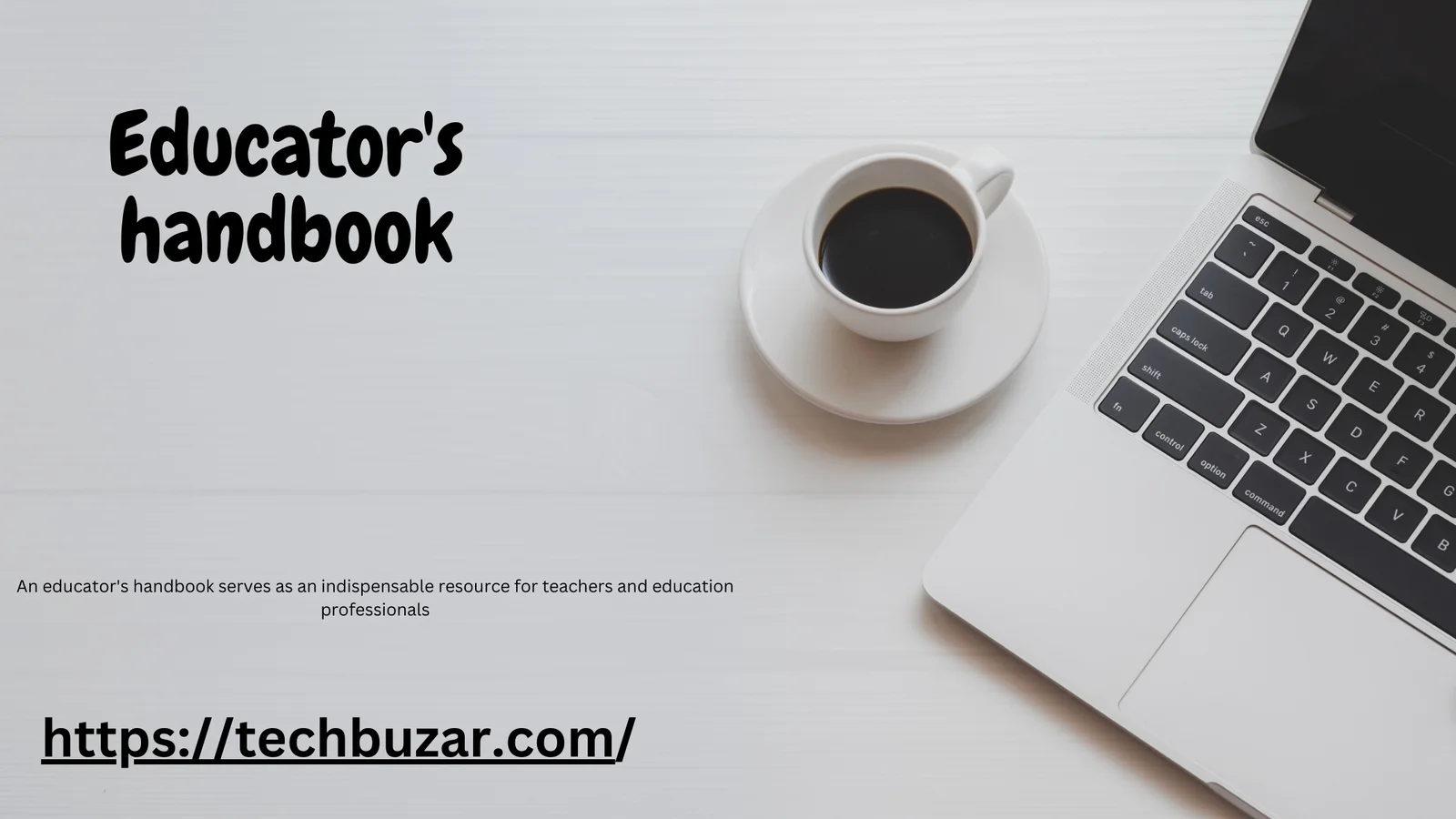In the present continually developing instructive scene, the job of educators has become more urgent than any time in recent memory. They are not only liable for giving information and abilities to understudies, yet additionally for molding their general turn of events and setting them up for what’s in store. Thus, the assumptions from educators have expanded, making it basic for them to have an exhaustive comprehension of powerful instructing rehearses. This is where the Instructor’s Educator’s Handbook becomes an integral factor, filling in as a one-stop guide for educators to explore through the difficulties and requests of cutting edge schooling.
1. The Role of Educators
Prior to digging into the particulars of the Teacher’s Handbook, it is critical to comprehend the fundamental job that educators play in our general public. They are liable for supporting youthful personalities, giving information, and planning understudies for the difficulties of this present reality. Notwithstanding scholastic guidance, educators likewise assume a vital part in creating social and profound abilities, advancing decisive reasoning, and cultivating an affection for learning in understudies.
The Changing Landscape of Education
The conventional idea of training, where educators were viewed as the sole wellspring of information and authority in the study hall, has gone through a critical change throughout the long term. With the approach of innovation and simple admittance to data, understudies are as of now not latent beneficiaries of information. Today, educators are supposed to be facilitators of getting the hang of, establishing a climate that advances coordinated effort, imagination, and free reasoning.
2. The Educator’s Handbook: A Comprehensive Guide
Perceiving the multi-layered job of educators, the Teacher’s Handbook fills in as a thorough aide for compelling educating. It is a significant asset for both novice and experienced educators, furnishing them with a structure to explore through the intricacies of showing in the 21st 100 years.
Understanding the Educator’s Handbook
The Teacher’s Handbook covers a large number of subjects, from building a strong learning climate to consolidating innovation in the study hall. It is intended to assist educators with figuring out the critical ideas and standards of successful instructing, and apply them in their everyday practice.
3. Essential Tools for Educators
In the present computerized age, educators approach a plenty of devices and assets that can upgrade their instructing rehearses. The Teacher’s Handbook features a portion of the fundamental instruments and innovations that can be coordinated into the homeroom to make a drawing in and intelligent opportunity for growth for understudies.
Technology Integration
Innovation has upset the manner in which we live, work, and learn. In the training area, it has opened up additional opportunities for educators to convey guidance, draw in understudies, and evaluate their learning. The Instructor’s Handbook gives an exhaustive outline of different innovation devices like computer generated experience, man-made consciousness, and gamification, and how they can be utilized to upgrade educating and learning.
4. Building a Supportive Learning Environment
Establishing a positive and steady learning climate is pivotal for the comprehensive improvement of understudies. The Teacher’s Handbook offers useful hints and procedures for educators to lay out a protected, comprehensive, and supporting learning climate where understudies feel enabled to face challenges, share their thoughts, and gain from their missteps.
Classroom Management
Successful homeroom the executives is fundamental for establishing a helpful learning climate. The handbook gives bits of knowledge into different homeroom the board methods, like laying out clear principles and assumptions, uplifting feedback, and tending to understudy conduct. It likewise features the significance of building positive associations with understudies, as it can altogether affect their inspiration and commitment to the homeroom.
5. Teaching Strategies and Methodologies
The Instructor’s Handbook perceives that every understudy is special, and there is nobody size-fits-all way to deal with educating. It stresses the significance of using different training procedures and approaches to take care of the assorted requirements of understudies.
Differentiated Instruction
Separated guidance is a methodology that includes adjusting the educational plan, informative strategies, and appraisal procedures to meet the singular requirements of understudies. The handbook gives reasonable tips to educators to carry out separated guidance in their homerooms, including distinguishing understudies’ learning styles, utilizing adaptable gathering, and giving different method for portrayal and articulation.
6. Assessment and Evaluation
Appraisal and assessment are basic parts of powerful educating. They not just assist educators with checking understudies’ comprehension and advance yet in addition give significant criticism to further develop their instructing rehearses.
Educator’s Handbook: Formative and Summative Assessments
Developmental evaluations are progressing appraisals that occur during the growing experience, while summative appraisals are utilized to assess understudy execution toward the finish of a unit or course. The handbook gives direction on planning and executing both developmental and summative appraisals that line up with learning targets and give significant criticism to understudies.
7. Collaboration and Professional Development
Coordinated effort and consistent expert improvement are fundamental for educators to remain refreshed with the most recent showing rehearses and fill in their calling. The Teacher’s Handbook features the significance of cooperation and gives tips and techniques to educators to take part in proficient learning networks, go to gatherings, and search out new open doors for development.
Educator’s Handbook: Teacher Collaboration
Cooperation among instructors encourages a feeling of local area as well as advances the sharing of thoughts, assets, and best practices. The handbook talks about different manners by which instructors can work together, for example, co-educating, peer perceptions, and group educating. It additionally features the advantages of cooperative preparation and how it can prompt more viable and strong guidance.
8. Educator’s Handbook: Special Education and Inclusion
Comprehensive schooling has turned into a main concern lately, with a more noteworthy accentuation on giving equivalent open doors to understudies with different capacities and necessities. The Teacher’s Handbook perceives the significance of incorporation and offers direction for educators to make a comprehensive homeroom where all understudies feel esteemed and upheld.
Differentiated Instruction for Students with Special Needs
The handbook gives down to earth procedures to educators to separate guidance for understudies with unique necessities, incorporating those with learning handicaps, ADHD, and skill. It underlines the significance of figuring out individual understudies’ assets and moves and fitting guidance to meet their particular necessities.
9. Technology Integration
As innovation keeps on propelling, its reconciliation in schooling will just increment. The Instructor’s Handbook features the advantages of innovation joining as well as gives reasonable tips to educators to integrate it really into their instructing practice.
Educator’s Handbook: Blended Learning
Mixed learning is a blend of customary eye to eye guidance and internet learning. The handbook frames the advantages of mixed learning and gives rules to educators to plan and execute powerful mixed opportunities for growth for their understudies.
10. The Future of Education
The last part of the Teacher’s Handbook takes a gander at the fate of schooling and how educators can get ready themselves and their understudies for it. As innovation keeps on upsetting customary showing strategies, educators should adjust and advance to satisfy the changing needs representing things to come.
Educator’s Handbook: Lifelong Learning
The handbook focuses on the significance of long lasting advancing and how it is pivotal for educators to stay up with arising patterns and headways in schooling. It likewise urges educators to impart an affection for learning in their understudies, setting them up for a future where constant learning and transformation are fundamental.
Conclusion
All in all, the Teacher’s Handbook fills in as a priceless aide for educators, outfitting them with the information, abilities, and devices vital for successful instructing. It gives reasonable procedures and tips to building a steady learning climate, using innovation, executing separated guidance, and teaming up with partners. By consolidating the standards framed in this handbook, educators can make connecting with and significant growth opportunities for their understudies, setting them up for an effective future.




